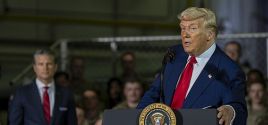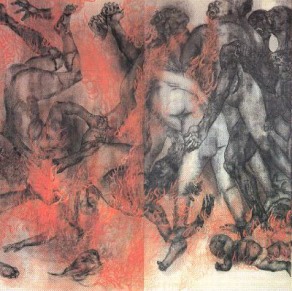Living Death: The Eternal Now of HiroshimaChris FloydAug. 09, 2008 |
Popular 
Eloy Adrian Camarillo, 17, Arrested in Shooting Death of Infowars Reporter Jamie White

NYT: Trump Ended War With Houthis After They Shot Down U.S. Drones, Nearly Hit Fighter Jets

Ben Shapiro, Mark Levin and Laura Loomer Warn of Foreign Influence... From Qatar

Report: Hamas Says Witkoff Promised to Lift Gaza Blockade in Exchange for Edan Alexander

Trump Advisor to Washington Post: 'In MAGA, We Are Not Bibi Fans'
  I once shared an office for a time with a Japanese scientist from Hiroshima. It was a strange setting for such an association: we were working at Oak Ridge National Laboratory (ORNL), where the atomic bomb that obliterated my colleague's city -- 63 years ago today -- was fashioned. I once shared an office for a time with a Japanese scientist from Hiroshima. It was a strange setting for such an association: we were working at Oak Ridge National Laboratory (ORNL), where the atomic bomb that obliterated my colleague's city -- 63 years ago today -- was fashioned. He never mentioned the bombing; he was too young to have experienced it himself, although some of his family certainly would have. I sometimes felt a bit awkward in his presence, as if I should say something about it, make some kind of apology. But what could you say? "Oh, sorry we destroyed your city and killed all those people in such a gruesome way when we really didn't have to. Hey, could you pass me that stapler?" Ridiculous. Pointless. In any case, we had a good time, a lot of laughs, during the months he was there, along with our other officemate, an American scientist who had been a conscientious objector during the Vietnam War, and had been sentenced to do public service for refusing to fight. He spent most of the war working in a juvenile detention center for troubled Native American adolescents somewhere in the Dakotas. Politics was a constant theme of our conversations, especially during that period: it was the time of the first war against Iraq, which, like the current one, had been the product of cynical manipulations, rank propaganda and outright deceit by national leaders named Bush and Cheney. ORNL itself was a sprawling, labyrinthine complex, something like an college campus -- albeit one surrounded by walls topped with barbed wire and patrolled by armed guards -- which was in turn part of a much larger complex of laboratories and huge technical facilities scattered throughout that rural area of East Tennessee, all of which had contributed to the creation of the bomb. During World War II, the federal government had constructed not only the secret laboratories but an entire secret city, Oak Ridge, to house the tens of thousands of scientists, technicians and laborers. My grandfather had helped build the housing there. He was a carpenter in Middle Tennessee, one of thousands of workers requisitioned into service by the government. He spent months building the secret city, returning home only on weekends, and was strictly forbidden to tell his family where he was working or what he was doing. By my day, all weapons production long ceased, and the complexes had been turned into research facilities in a variety of areas. When I was there, as a technical editor, I worked on projects dealing with global warming, energy conservation, transportation and artificial intelligence. I also worked with a remarkable scientist who wanted to set up a new "Court of the Generations," a kind of Supreme Court that would consider the effects of current policies -- particularly technological and scientific developments -- on future generations, and act as an advocate for them. I helped prepare his presentation to Congress on the matter. Obviously, the idea went nowhere: Future generations? Are you kidding? Who cares? Or as George W. Bush once put it so eloquently: "History? We don't know. We'll all be dead." Still, it was an intriguing idea: one that might have come in handy during the early days of the laboratory, in the feverish rush to build -- and use -- atomic weapons. Here too, amidst all the secrecy and feverish activity, there was deceit and manipulation at work. As John Pilger notes in a blistering article in the Guardian on the anniversary of Hiroshima's destruction, the stated justifications for using this horrific weapon on a civilian population have all been exposed as deliberate falsehoods. Pilger writes: The atomic bombing of Hiroshima and Nagasaki was a criminal act on an epic scale. It was premeditated mass murder that unleashed a weapon of intrinsic criminality. For this reason its apologists have sought refuge in the mythology of the ultimate "good war", whose "ethical bath", as Richard Drayton called it, has allowed the west not only to expiate its bloody imperial past but to promote 60 years of rapacious war, always beneath the shadow of The Bomb.Pilger then concludes: ...In waging their bogus "war on terror", the present governments in Washington and London have declared they are prepared to make "pre-emptive" nuclear strikes against non-nuclear states. With each stroke toward the midnight of a nuclear Armageddon, the lies of justification grow more outrageous. Iran is the current "threat". But Iran has no nuclear weapons and the disinformation that it is planning a nuclear arsenal comes largely from a discredited CIA-sponsored Iranian opposition group, the MEK - just as the lies about Saddam Hussein's weapons of mass destruction originated with the Iraqi National Congress, set up by Washington...The fate of Hiroshima is still with us, like those shadows of the victims permanently burned into the stones of the city by the flash of the bomb, as Pilger describes at the beginning of his article. It affects not only the survivors of that first blast, and their descendants, like my Oak Ridge colleague, but all of us. Several generations, including mine, were brought up with the threat of imminent nuclear destruction constantly pressed upon us, as Gregory McNamee describes in his book, Blue Mountains Far Away. (The relevant chapter can be found here). The manufactured crisis with Iran has brought a little something of that anxiety-riddled atmosphere back to public consciousness -- and, as Pilger notes, the Terror War has made the possibility of another American use of nuclear weapons on defenseless citizens in a non-nuclear country far more likely. The Atomic Age ushered in by the attack on Hiroshima has produced a kind of quantum-state apocalypse, one that is both here and not-here, but which can be actuated at any moment. McNamee quotes a passage from Susan Sontag that aptly sums up our strange and warping state of being: ...a permanent modern scenario: apocalypse looms, and it doesn't occur.... Apocalypse has become an event that is happening, and not happening. It may be that some of the most feared events, like those involving the irreparable ruin of the environment, have already happened. But we don't know it yet, because the standards have changed. Or because we do not have the right indexes for measuring the catastrophe. Or simply because this is a catastrophe in slow motion.The nuclear age is indeed a catastrophe in slow motion. Given all that we know of human nature, it is almost inconceivable that these monstrous weapons will not be used again, either individually, as against Japan, or en masse, as in the fearsome Cold War scenarios. It all began in Hiroshima 63 years ago, but that horrible moment -- the searing flash and the poison wind -- has not yet ended; the slow-motion catastrophe is still unfolding, inside us and all around us. *Picture from The Hiroshima Panels by Maruki Iri and Maruki Toshi.* |



